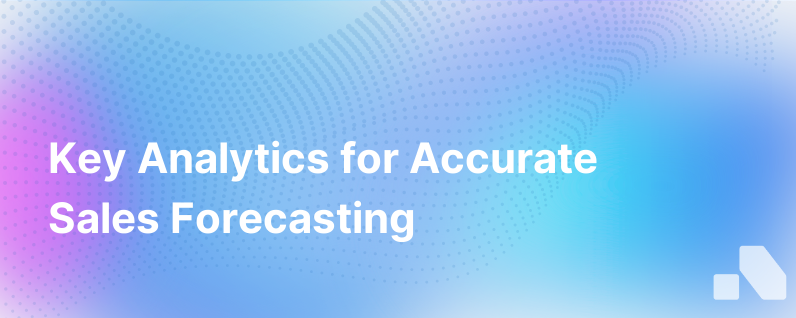
In the dynamic sphere of sales, being able to anticipate the future gives businesses an indispensable advantage. Sales forecasting is the process that attempts to estimate the future sales volume over a given period. Accurate sales forecasts not only help companies to make informed business decisions but also manage resources efficiently, set realistic goals, and measure progress against them.
However, the accuracy of sales forecasts highly depends on the analytics that fuel the estimations. In this article, we will delve deep into the three types of analytics—descriptive, predictive, and prescriptive—that are vital to crystalize your sales forecasting process.
1. Descriptive Analytics: Understanding the 'What'
As the foundational tier of analytics, descriptive analytics involves analyzing historical data to understand 'what happened?' in a business' past performance. This form of analytics relies on data aggregation and data mining processes to provide valuable insights into sales trends and patterns. You'll recognize descriptive analytics in the form of sales reports, dashboards, and basic data queries that reflect past performance.
Why It Matters: Descriptive analytics is crucial because it sets the stage for more advanced analysis by providing a clear picture of past sales performances. This snapshot includes metrics like total sales per period, conversion rates, average deal size, and customer demographics. Sales managers use this data to spot past trends, seasonal patterns, sales cycles, and historical growth rates—all of which serve as benchmarks for future predictions.
2. Predictive Analytics: Projecting the 'What Could Happen?'
Taking a step beyond descriptive analytics, predictive analytics answers the question 'what could happen?' in the future based on current and historic trends. It encompasses various statistical techniques, including data mining, machine learning, and modeling, that analyze current and historical facts to make predictions about future sales outcomes.
Key Components of Predictive Analytics:
- Data Models: Sophisticated algorithms that anticipate future results based on patterns identified in historical and transactional data.
- Customer Profiling: Analyzing past customer behavior to predict how similar profiles will act in the future.
- Lead Scoring: Assigning a numerical value to each lead to predict how likely they are to move through the sales funnel.
Why It Matters: Predictive analytics informs sales performance forecasts, helping organizations anticipate demand, adjust pricing models, identify potential market shifts, and allocate resources. A predictive sales forecast can flag potential downturns in revenue, ensuring that a business is not caught off guard and can pivot strategy where necessary. It provides actionable insights on forecasting trends and leads' propensity to buy, allowing for more strategic sales approaches.
3. Prescriptive Analytics: Defining the 'What Should We Do?'
Now, moving towards the pinnacle of analytics sophistication, we encounter prescriptive analytics. It answers not just 'what will happen?' but 'what should we do?' It goes beyond predicting future outcomes by also suggesting actions that can advantageously impact those outcomes. Prescriptive analytics uses advanced techniques such as machine learning, algorithms, and computational modeling procedures to recommend one or more courses of action and show the likely outcome of each decision.
Key Benefits of Prescriptive Analytics:
- Optimal Decision-Making: Prescriptive analytics empowers leaders to make data-backed decisions by showing the probable outcomes of different action paths.
- Efficient Resource Allocation: It helps identify the most effective ways to deploy resources for maximum sales impact.
- Dynamic Sales Strategies: With real-time data analysis, sales strategies can be dynamically adjusted for the highest success probability.
Why It Matters: Prescriptive analytics is a game-changer for sales forecasting because it enables sales teams to be proactive rather than reactive. Armed with data-driven recommendations, you can optimize sales strategies and tactical moves to shape future outcomes more favorably. This analytic type helps identify the best customers to pursue, the most effective engagement strategies, and the ideal timing for outreach—all tailored to boosting sales efficacy.
Integrating Analytics into Sales Forecasting
While having a handle on these three analytics types is vital, integrating them into a unified sales forecasting strategy is key. Here's a brief on how to incorporate these analytics into the sales forecasting process:
Data Foundation: Aggregate both structured and unstructured data from various sources for a comprehensive dataset.
Descriptive Analysis: Begin with creating a descriptive report of your historical sales data to establish benchmarks.
Predictive Modeling: Use the insights from descriptive analytics to develop predictive models that will outline potential future sales trends.
Prescriptive Strategy: From the predictive model's outcomes, derive prescriptive strategies to tackle potential scenarios actively.
Integration and Automation Tools: Use sales forecast software and analytics platforms that blend these three types seamlessly for ongoing sales forecasting. Aomni, for instance, provides an AI-driven platform that assimilates real-time account research, competitive insights, and personalized sales content, serving as an example where descriptive, predictive, and prescriptive analytics are synthesized for strategic selling—all accessible in about 15 minutes with zero manual effort.
Conclusion
Today's rapidly evolving market conditions demand that sales forecasting not be a static, one-dimensional facet of a business. Integrating descriptive, predictive, and prescriptive analytics provides a multi-angled view of what's to come, prepares a plan of action, and sets you up with a reaction strategy, thus making sales forecasts insightful and actionable. Doing so will help ensure that your sales organization isn't just informed about possible future states but ready with a structured response, leveraging opportunities and mitigating risks with precision and strategic foresight.